Difference between revisions of "Storage of leather"
(Created page with "<p align=center> 300px </p> <p align=center> 165px 165px bild:Lagerung-Hauf...") |
|||
| Line 13: | Line 13: | ||
Leder werden oft auf dem Weg von der Gerberei bis zur Verarbeitung zwischengelagert. Gelagert wird das Leder in der [[Gerberei]], beim [[Lederhändler]] oder beim lederverarbeitenden Betrieb. Um Schäden zu vermeiden, muss die Lagerung sachgerecht erfolgen. | Leder werden oft auf dem Weg von der Gerberei bis zur Verarbeitung zwischengelagert. Gelagert wird das Leder in der [[Gerberei]], beim [[Lederhändler]] oder beim lederverarbeitenden Betrieb. Um Schäden zu vermeiden, muss die Lagerung sachgerecht erfolgen. | ||
| − | + | Leather is often stored after [[leather production|tanning]] and before processing. The leather is stored in the [[tannery]], at the [[Leather dealer|leather trader]] or at the leather processing company. In order to avoid damage, storage must be carried out properly. | |
| − | + | Leather is usually stored in shelves, on racks or hanging. | |
| − | + | The leather [[leather quality|properties]] elasticity and softness bear a relation to to a certain moisture content of the leather. The storage of the leather should therefore be carried out in not too dry rooms with good ventilation at a uniform temperature of 15 - 20 ° C and a relative humidity between 50 - 70%. Higher temperatures should be avoided, lower temperatures up to 10 ° C are not a problem. But fluctuating temperatures and constant changes in humidity should be avoided as far as possible to not promote aging of the leather. | |
| − | + | If the humidity is too low, the leather becomes [[Leather damages|brittle and harder]] over time. If the air humidity is too high and / or the air circulation is insufficient, there is a risk of [[Moldy leather - Mouldy leather (US)|mold formation]] with the corresponding [[Leather smell|odor]]. Avoid direct sunlight. The leather can [[Colour fastness - Light fastness of leather|fade]] and age faster. Leather should never be stored directly on cement floors or airtight, as there is a risk of condensation. This can lead to stains and [[Moldy leather - Mouldy leather (US)|mold growth]]. | |
| − | + | It is advisable to store the leather on shelves, with the lowest shelf being at least 10 cm from the floor and the leather should be stacked up to a maximum of 50 to 60 cm. If the stacks are too high, especially strongly [[Oils & fats in the leather industry|greased leathers]] can lead to burn damage. By the pressure of the weight, the leather can heat up. | |
| − | + | The leather should be stored as flat as possible to avoid [[Dents - Over stretching - Sagging in leather|wrinkles and bumps]]. A leather storage should be kept clean and also [[Vermin damage on leather|vermin]] must be respected. Therefore, the leather should be regularly inspected in the warehouse. | |
| + | |||
| + | Never store [[Oils & fats in the leather industry|oily ore greasy]] leather with other leathers to avoid stains. | ||
| + | |||
| + | Don`t store different colours together to avoid [[Leather damages#Dye transfer on leather|dye transfer]] and the transfer of different colored leather fibers from the [[flesh side]]. | ||
| + | |||
| + | Newly delivered leather should always be inspected and relocated as soon as possible as the transport storage is usually not optimal for longer periods of time. | ||
| Line 32: | Line 38: | ||
</p> | </p> | ||
<p align=center> | <p align=center> | ||
| − | '' | + | ''Too much pressure on the leather leads to [[Dents - Over stretching - Sagging in leather|wrinkles and small bumps]].''<br></p> |
<p> </p> | <p> </p> | ||
| Line 40: | Line 46: | ||
</p> | </p> | ||
<p align=center> | <p align=center> | ||
| − | '' | + | ''Typical folds from incorrect storage. This must be sorted out in the final inspection.''<br></p> |
<p> </p> | <p> </p> | ||
| − | + | Freshly [[finish|finished]] leather may only be stored with a small load and without external heating, as otherwise the risk of gluing together of the leather can not be excluded. | |
| − | + | ||
| Line 52: | Line 57: | ||
</p> | </p> | ||
<p align=center> | <p align=center> | ||
| − | '' | + | ''Leather storage in a [[tannery]] for [[furniture leather]].''<br></p> |
<p> </p> | <p> </p> | ||
<p align=center> | <p align=center> | ||
| Line 63: | Line 68: | ||
</p> | </p> | ||
<p align=center> | <p align=center> | ||
| − | '' | + | ''Leather storage in a [[Leather dealer|leather merchant's]] store and at a [[leather furniture|furniture dealer]].''<br></p> |
<p> </p> | <p> </p> | ||
| Line 70: | Line 75: | ||
</p> | </p> | ||
<p align=center> | <p align=center> | ||
| − | '' | + | ''Approx. 100 hides = Approx. 500 square meters of leather on a transport trolley. - Delivery to the [[car leather|car industry]].''<br></p> |
<p> </p> | <p> </p> | ||
| − | + | If stored incorrectly, leather gets creases and folds. It is much better to hang the leather during storage. Due to the weight of the leather, the [[Dents - Over stretching - Sagging in leather|folds]] are partly pulled out. Heat also can help. During the processing of the leather, hot air guns can be used and sometimes folds are also [[Ironing leather|ironed]]. Some experts wet the leather before, to facilitate the procedure. The longer the leather was stored incorrectly, the more difficult it is to remove the [[Dents - Over stretching - Sagging in leather|wrinkles]] again. | |
| − | + | ||
| Line 82: | Line 86: | ||
</p> | </p> | ||
<p align=center> | <p align=center> | ||
| − | '' | + | ''Hanging leather. The most perfect variant. - This [[Dents - Over stretching - Sagging in leather|fold]] should not have been so processed..''<br></p> |
<p> </p> | <p> </p> | ||
| − | + | The cleanliness of a leather or leather goods store is an absolute prerequisite. In addition to many other pests, which are only accidentally eating the leather (mice, rats, etc.), the larvae of of some beetles (leather worm) eat particularly [[vegetable-tanned leather]]. | |
<p align=center> | <p align=center> | ||
| − | [[bild:Wurmschaden-Buch-01.jpg| | + | [[bild:Wurmschaden-Buch-01.jpg|258px]] |
| − | [[bild:Wurmschaden-Buch-02.jpg| | + | [[bild:Wurmschaden-Buch-02.jpg|239px]] |
</p> | </p> | ||
<p align=center> | <p align=center> | ||
| − | ''[[ | + | ''[[Vermin damage on leather|Vermin damage]] at old [[Leather book cover|book covers]].''<br></p> |
<p> </p> | <p> </p> | ||
| Line 100: | Line 104: | ||
== Additional information == | == Additional information == | ||
| − | * [[ | + | * [[Dents - Over stretching - Sagging in leather]] |
| − | * [[ | + | * [[Formed leather|Wished deformation of leather]] |
| − | * [[ | + | * [[Embossed leather|Wished deformation by embossing]] |
| − | * [[ | + | * [[Preservation by drying, salting or freezing|The storing of rawhides]] |
Revision as of 21:29, 18 December 2016
Leder werden oft auf dem Weg von der Gerberei bis zur Verarbeitung zwischengelagert. Gelagert wird das Leder in der Gerberei, beim Lederhändler oder beim lederverarbeitenden Betrieb. Um Schäden zu vermeiden, muss die Lagerung sachgerecht erfolgen.
Leather is often stored after tanning and before processing. The leather is stored in the tannery, at the leather trader or at the leather processing company. In order to avoid damage, storage must be carried out properly.
Leather is usually stored in shelves, on racks or hanging.
The leather properties elasticity and softness bear a relation to to a certain moisture content of the leather. The storage of the leather should therefore be carried out in not too dry rooms with good ventilation at a uniform temperature of 15 - 20 ° C and a relative humidity between 50 - 70%. Higher temperatures should be avoided, lower temperatures up to 10 ° C are not a problem. But fluctuating temperatures and constant changes in humidity should be avoided as far as possible to not promote aging of the leather.
If the humidity is too low, the leather becomes brittle and harder over time. If the air humidity is too high and / or the air circulation is insufficient, there is a risk of mold formation with the corresponding odor. Avoid direct sunlight. The leather can fade and age faster. Leather should never be stored directly on cement floors or airtight, as there is a risk of condensation. This can lead to stains and mold growth.
It is advisable to store the leather on shelves, with the lowest shelf being at least 10 cm from the floor and the leather should be stacked up to a maximum of 50 to 60 cm. If the stacks are too high, especially strongly greased leathers can lead to burn damage. By the pressure of the weight, the leather can heat up.
The leather should be stored as flat as possible to avoid wrinkles and bumps. A leather storage should be kept clean and also vermin must be respected. Therefore, the leather should be regularly inspected in the warehouse.
Never store oily ore greasy leather with other leathers to avoid stains.
Don`t store different colours together to avoid dye transfer and the transfer of different colored leather fibers from the flesh side.
Newly delivered leather should always be inspected and relocated as soon as possible as the transport storage is usually not optimal for longer periods of time.
Too much pressure on the leather leads to wrinkles and small bumps.
Typical folds from incorrect storage. This must be sorted out in the final inspection.
Freshly finished leather may only be stored with a small load and without external heating, as otherwise the risk of gluing together of the leather can not be excluded.
Leather storage in a tannery for furniture leather.
Leather storage in a leather merchant's store and at a furniture dealer.
Approx. 100 hides = Approx. 500 square meters of leather on a transport trolley. - Delivery to the car industry.
If stored incorrectly, leather gets creases and folds. It is much better to hang the leather during storage. Due to the weight of the leather, the folds are partly pulled out. Heat also can help. During the processing of the leather, hot air guns can be used and sometimes folds are also ironed. Some experts wet the leather before, to facilitate the procedure. The longer the leather was stored incorrectly, the more difficult it is to remove the wrinkles again.
Hanging leather. The most perfect variant. - This fold should not have been so processed..
The cleanliness of a leather or leather goods store is an absolute prerequisite. In addition to many other pests, which are only accidentally eating the leather (mice, rats, etc.), the larvae of of some beetles (leather worm) eat particularly vegetable-tanned leather.
Vermin damage at old book covers.
Additional information
- Dents - Over stretching - Sagging in leather
- Wished deformation of leather
- Wished deformation by embossing
- The storing of rawhides







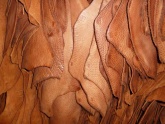
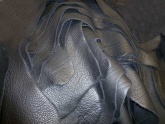
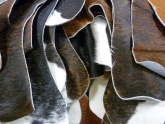
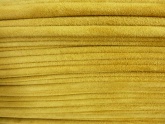
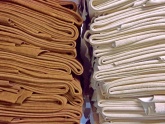
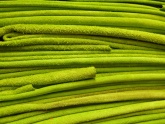

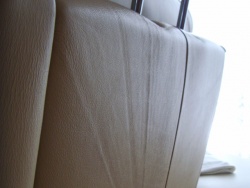
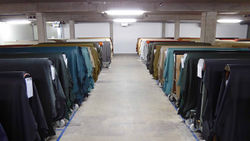
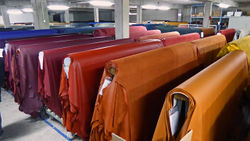






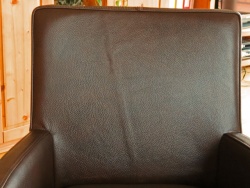
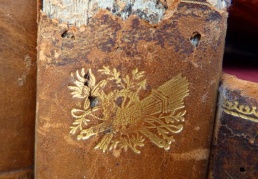


 a kotori web solution
a kotori web solution